March 28
This was the second day on my trip to the Ashizuri area.
Although the forecast was "cloudy then rain", weather had been
perfect since the morning.
Yesterday, the view of the inlet at dusk resembled a scene
from an old oil painting, but this morning in the sunlight it was like
a freshly painted watercolor picture. As soon as the first sunlight arrived,
the inlet awoke from the night's deep sleep and the beaches hidden in the
darkness until then became brightened and energized.
I left the hotel at 10 o'clock in the morning and drove along
the southern shoreline of the peninsular. I stopped by a place called "Usubae"
famous for fishing, which I had visited about 5 years before. It was a
breathtaking scenery of stunningly beautiful rocks of unusual shapes jutting
out into the air. I felt as if I were visiting the magical "Ryugujo"
Palace at the bottom of the ocean in children's fairytale . It must be
a haven for anglers known only to them. The scenery seen from a 100-meter-
tall viewing platform was magnificent. If you keep driving to the east
you will pass through Kanaezaki and go around Cape Ashizurimisaki to reach
the city of Shimanto. Ohkinohama Beach seen on your way to Shimanto is
always refreshingly beautiful no matter how many times you have seen it.
I was told that, in the past, city-based developers had attempted to turn
this beautiful beach into a resort city. I hope that the beauty of nature
is preserved intact. I wonder what the night sky will be like at the nightfall.
The stars shining over a beautiful scenery is said to be especially pretty.
One day, when the stars are shining over Ohkinohama Beach, I would like
to come over here.

The sea beyond rows of strange-looking rocks at Usubae
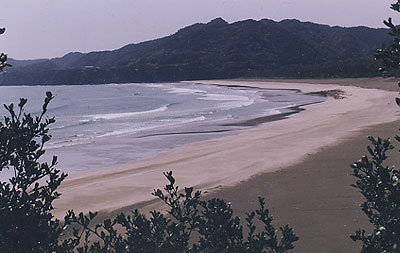
Incredibly beautiful Ohkinohama Beach
I visited Ashizuri.
During the afternoon on a pleasant spring day, I had a sudden
urge to see the sea around Ashizuri Peninsula and went to the town of Otsuki
in Kochi prefecture. About 20 years ago, when Halley's Comet appeared,
I traveled to the shore of Inan located in the same area. Kashinishi Park
was an excellent observing site from where you could see the ocean beyond
the southern slope. This southern most peninsular of Shikoku covered by
tropical trees was glowing in intense sunlight and made me realize that
I had come far south. The old children's song "The sea of Otsuki glowing
pink" has been sung in Tosa for a long time. Children in Kochi City,
too, sang this song very often. Coral grows in the sea near Otuski and
it is said to make the blue water shine in pink.
Tosa (Kochi) was once ruled by Lord Yamauchi. Fearing that
the Shogunate would learn about the coral and order him to present coral
as a gift, Lord Yamauchi decreed that residents of Otsuki were not allowed
to tell outsiders of Otsuki's coral. However, before long the story reached
the Tokugawa Shogunate and Lord Yamauchi was forced to present coral to
the Shogunate every year. Coral divers were blamed for telling about Otsuki's
coral to outsiders. The sound of the waves at the Sea of Otsuki seems to
be trying to tell us this story. As expected, I found beautiful coral necklaces
and other accessories being sold at the hotel where I stayed that night.
Hotel Bellreef Otuski where I stayed was a modern hotel and
I was able to see truly stunning views of the sea from my room. The waves
in the inlet were interacting with the sand of the beach silently. The
beautiful silhouette of the small offshore islands floated on the sea in
evening twilight. At nightfall the deep darkness arrived at the inlet surrounded
by low mountains. How dark it was! As far as I could see, there wasn't
a single light source. No stars were shining; perhaps it was overcast.
It was pitch dark. The sky and sea were in complete darkness. A small part
of the sky was faintly glowing white. It might be lights from Otsuki behind
us. Even clouds were black, too, and it was frighteningly quiet. "I
wish I could observe at a dark place like this...", I sighed.
Tomorrow, I am going to Usubae, a little haven on Ashizuri
Peninsula, which, they say, is the first point of the Japanese archipelago
that the warm Kuroshio ocean current hits. It is a majestic shoreline where
the Kuroshio current violently crushes with strange-looking reddish rocks.
The vital life force "chi" is felt hanging in the air.
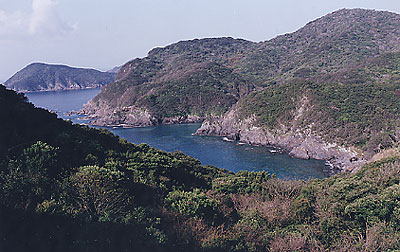
The inlet of the Sea of Otsuki viewed from the hotel room
I visited Koiwai Farm Observatory.
Last night, the third day of my visit to Iwate prefecture,
I stayed at the Hanamaki hot springs resort. I walked to an outdoor bath
amid the snow-covered landscape. The stars were shining in the dark sky
and it looked very cold, but the air was surprisingly warm. Why was it?
I immersed myself in calm warm water and looked up at the sky. I imagined
that perhaps the famous Iwate-born poet Kenji Miyazawa had created poems
while contemplating the stars in a hot spring like this.
During the morning of March 6, I visited historical places
at Hiraizumi and in the afternoon the museum at Hanamaki dedicated to Kenji
Miyazawa, accompanied by Messrs. Sakae Sakai and Hisashi Sugawara.
Later, I stopped by Koiwai Farm in the town of Shizukuishi-machi.
I met Mr. Koichi Kozaki there who was a past member of OAA and used to
read our Comet Bulletin. I visited the astronomical facilities on the farm.
I was impressed by Hevelius's "air telescope", which was over
10 meters long, as well as Nikon's 20cm equatorial refractor kept in a
perfect condition. I think that there are only about five 20cm Nikon refractors
still in use in Japan. The snow covered farm extended as far as the eye
could see, majestic Mt. Iwatesan was shining pure white over the farm in
the distance, and the legendary Nikon refractor in a perfect condition
was still in use. These are the stately symbols of Iwate Prefecture. I
felt good seeing magnificent things about Japan
This trip was primarily for giving talks, but I had a strong
lasting impression of local residents' warm friendship and a grand scale
of the snow-covered country.
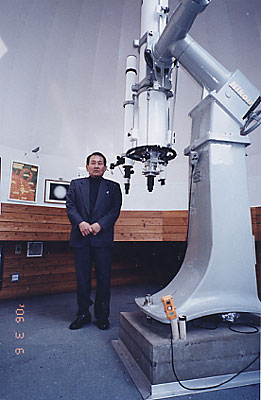
Under the 20cm refractor at Koiwai Farm Observatory
A minor planet was named after Dr. Aikitsu Tanakadate.
I visited Tanakadate Science Museum in Ninohe City today.
The city also held a celebration for the naming of a minor planet after
Dr. Tanakadate. With the mayor's presence, I told the gathering about the
naming of Minor Planet Tanakadate and provided related information to the
city. Thus Minor Planet Tanakadate was born. Dr. Aikitsu Tanakadate preceded
such distinguished scientists as Hisashi Kimura and Torahiko Terada. In
a small northern town with a population of only 30,000, the modern building
of the museum stands out as the symbol of the town's cultural heritage.
I felt a tinge of sadness about the paucity of scientific facilities in
Tosa which could proudly acknowledge the achievements of the great Tosa-born
scientists like Torahiko Terada.
A get-together organized by Ihatov Space Action Center in
the town was held in a pleasant atmosphere today. The party was livened
up by the presence of astronomers from the National Observatory, Mr. Yoshihiro
Yamada who came all the way from Kobe as well as Mr. Ishii, who previously
worked for Goto Optical Company. A local resident, Mr. Shigeki Tomura talked
in detail about Mr. Masamitsu Yamasaki, a former staff member of Mizusawa
Latitude Observatory. He attracted the attention of the participants by
presenting a rare book written by Mr. Yamasaki, which is no longer obtainable.
It was published in the late 1920s or early 30s and became very popular.
It was reprinted 10 times. The title of the book "Telescope Making"
was written in English on a beautiful front cover printed in color. The
book describes the method of mirror-grinding in quite detail. It was a
good contrast to Kaname Nakamura's "The method of Astrophotography",
which was exhibited alongside.
Some locals say there is no record of Mr. Yamasaki working
at Mizusawa Latitude Observatory, but information later sent to me by Mr.
Tomura tells that he had been busy with work at the observatory. He worked
in a pair with other staff members and pairs took turns at work. Apparently,
bad weather at Mizusawa did not allow him to search for a comet often.
But suddenly he discovered a comet on October 27, 1928 and writes the detailed
account of the discovery. While in America, Mr. Yamasaki had already been
searching for a comet with an 8-inch (20cm) mirror he had ground to see
Halley's Comet at its 1910 apparition. It was at Rick Observatory where
he was studying. He brought the mirror back to Japan and built a unique
comet seeker with it. Mr. Yamasaki claims in his book that it is the first
mirror in Japan. This may mean that he undertook mirror grinding before
Mr. Kaname Nakamura, Japan's renowned mirror maker.
I wonder where this mirror is. I heard that it had been bought
by his close friend Mr. Tatsuo Yamada of Aichi and then refigured by Mr.
Jiro Hoshino. But any more detail is unclear. Mr. Yamasaki is said to have
used this mirror for comet hunting with its aperture stopped down to 7
inches. Judging from that, the accuracy of the mirror surface seems not
to have been particularly good. Around 1955 I looked through his telescope
using a Ramsden eyepiece at 30x. I found the field width (70-minutes of
arc) narrow and star images near the edge distorted considerably. It was
nothing short of miracle that Mr. Yamasaki discovered a comet after searching
for only about one year using this comet seeker. It was, however, a great
achievement that no other Japanese accomplished at that time. He was certainly
a pioneer of Japanese astronomy. I will tell you more about Mr. Yamasaki
later, as there are countless episodes about him.
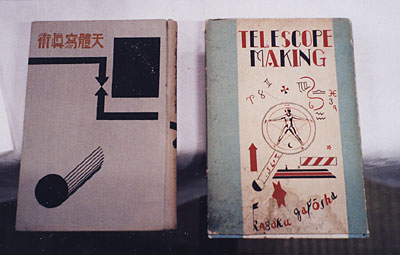
"The method of Astrophotography" by Kaname Nakamura (left)
and "Telescope Making" by Masamitsu Yamasaki (right)
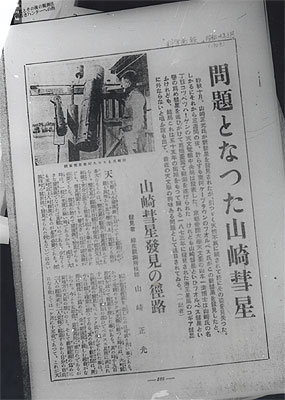
Masamitsu Yamasaki's discovery story
published in the 1929 March 3rd issue
of Scientific Pictorial.
Courtesy Shigeki Tomura.
After giving a talk on astronomy at Mizusawa in Oshu City,
Iwate prefecture, I had an opportunity to mix with many astronomy enthusiasts
in Iwate. Mr. Sakae Sakai of Mizusawa and Dr. Masatsugu Ooe, a former member
of the National Observatory, helped a great deal in organizing this event.
About 250 members of the public, rather than students, gathered at the
venue and after the talk I enjoyed meeting with many serious astronomy
enthusiasts.
I talked about the discovery of Comet Ikeya-Seki. Specially
important, though, is that the
music "Ikeya-Seki", composed by Jose Caleyo of Havana 41 years ago, was played for the first
time at the venue. It was a very unusual way of playing music that computer
software read the note and played it. The piano music reverberated strongly
throughout the hall and brought vividly to mind the comet's striking image
at its closest approach to the sun. While I was speaking, unexpected thoughts
about Comet Ikeya-Seki occurred to me one after the other and I was able
to put heart and soul into my talk.
During my 3-day stay in Iwate prefecture, I exchanged about
30 cards with people I met. Meeting so many people, it was a very useful
learning experience for me.
It was at Mizusawa where Mr. Masamitsu Yamasaki, a technical
officer, discovered a comet 78 years ago. Although there is not much information
on his discovery, there was a very unusual document kept by a local resident.
When I stood at a place on the observatory compound where
Mr. Yamasaki might have searched for a comet 78 years ago, the snow-covered
landscape spread in front of me. Mt. Iwatesan seen through haze seemed
to be telling the facts about Mr. Yamasaki's discovery, though it is now
an event far back in the past.
At a gathering that night an elderly local astronomer brought
out a very unusual thing which would tell a lot about Mr. Yamasaki.
That's all for today. I will stay at Hanamaki tomorrow.
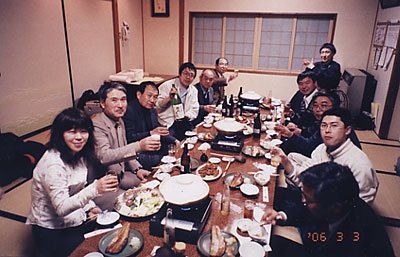
A get-together with local astronomical society members on March 3
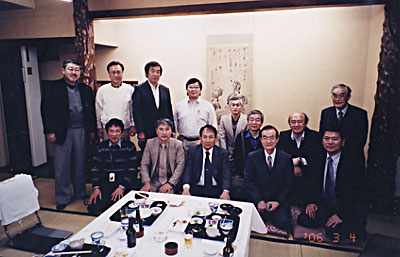
A get-together with astronomers from the National Observatory and residents
at Mizusawa on March 4
I visited the former Mizusawa Latitude Observatory. I had
long been dreaming about the visit. I toured the old building where Dr.
Hisashi Kimura, famous for his "z-term", worked. I also viewed
Kimura Museum dedicated for his work and life. I was given a tour of many
new facilities by Mr. Sakae Sakai with explanations provided by Mr. Kameya
of the National Observatory. A gigantic radio telescope to measure the
stellar parallax was slewing to the universe under a cloudy sky. I sensed
the transition of eras.
At Kimura Museum I saw Dr. Kimura's desk. He had used this
desk during his term at the observatory and it was preserved the way it
was 80 years ago. The idea of the z-term is said to have been born when
he slid out a drawer of the desk for no particular reason. I sat at the
desk and pulled out a drawer as Dr. Kimura would have, but nothing came
out. There is no particular theory behind the concept of the z-term. This
new term was experimentally added to an observational x-y equation as a
correction value, which resulted in a better match between observational
results and theoretical predictions. It is a simple principle, but a brilliant
concept. On his desk there was a five-beads soraban (abacus), which he
is said to have used to calculate many observational equations by ordinary
least squares (OLS). According to Mr. Masamitsu Yamasaki who worked at
the observatory as a technical staff member at that time, Dr. Kimura was
a master abacus calculator.
Eighty years have passed since. Dr. Kimura's room restored
to the original condition is simple, clean, and orderly. It symbolizes
his devotion to the study of latitudinal changes. From his desk lit by
the yellowish ceiling light, I learned the importance of unwavering dedication
of one's life to one's own goal in any field of work.
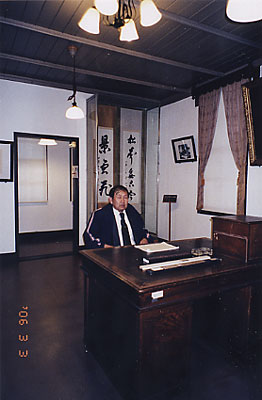
Seki sitting at Dr. Kimura's desk
(Kimura Museum)









